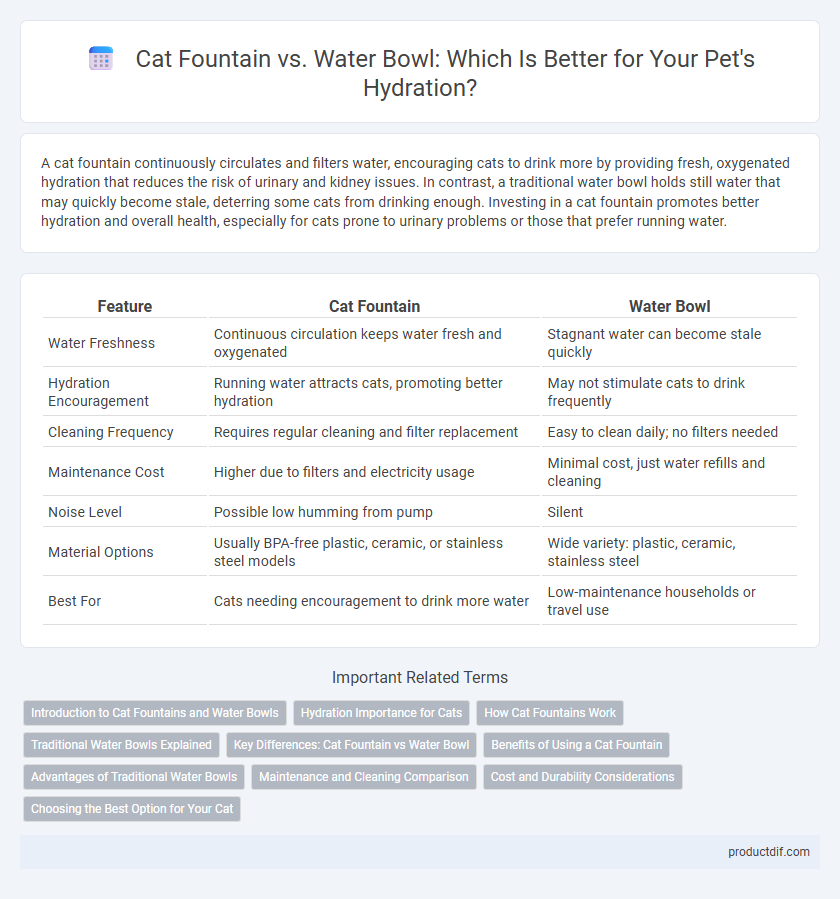A cat fountain continuously circulates and filters water, encouraging cats to drink more by providing fresh, oxygenated hydration that reduces the risk of urinary and kidney issues. In contrast, a traditional water bowl holds still water that may quickly become stale, deterring some cats from drinking enough. Investing in a cat fountain promotes better hydration and overall health, especially for cats prone to urinary problems or those that prefer running water.
Table of Comparison
| Feature | Cat Fountain | Water Bowl |
|---|---|---|
| Water Freshness | Continuous circulation keeps water fresh and oxygenated | Stagnant water can become stale quickly |
| Hydration Encouragement | Running water attracts cats, promoting better hydration | May not stimulate cats to drink frequently |
| Cleaning Frequency | Requires regular cleaning and filter replacement | Easy to clean daily; no filters needed |
| Maintenance Cost | Higher due to filters and electricity usage | Minimal cost, just water refills and cleaning |
| Noise Level | Possible low humming from pump | Silent |
| Material Options | Usually BPA-free plastic, ceramic, or stainless steel models | Wide variety: plastic, ceramic, stainless steel |
| Best For | Cats needing encouragement to drink more water | Low-maintenance households or travel use |
Introduction to Cat Fountains and Water Bowls
Cat fountains promote hydration by continuously circulating fresh water, which appeals to cats' natural instincts and encourages more frequent drinking. Traditional water bowls provide a static water source but can quickly become contaminated with debris or bacteria if not cleaned regularly. Choosing between a cat fountain and a water bowl depends on factors like convenience, maintenance, and a cat's individual drinking preferences.
Hydration Importance for Cats
Cat fountains promote increased hydration by providing fresh, circulating water that appeals to a cat's natural instincts, reducing the risk of urinary tract infections and kidney disease. Traditional water bowls often harbor bacteria and tend to be overlooked by cats due to stagnant water, leading to decreased water intake. Ensuring proper hydration through a cat fountain supports kidney function, improves overall health, and can prevent common feline urinary problems.
How Cat Fountains Work
Cat fountains continuously circulate and filter water, encouraging cats to drink more by providing fresh, oxygenated water. They typically use a small pump to create a steady flow, which helps prevent bacteria buildup and keeps the water cooler than stagnant water in a traditional bowl. This consistent movement mimics natural water sources, promoting better hydration and overall health for cats.
Traditional Water Bowls Explained
Traditional water bowls for cats are simple, usually made from materials like stainless steel, ceramic, or plastic, providing a stationary source of hydration. These bowls require frequent cleaning to prevent bacteria buildup and must be refilled regularly to ensure fresh water. Unlike cat fountains, traditional bowls lack continuous water circulation, which may result in less appealing water quality for some cats.
Key Differences: Cat Fountain vs Water Bowl
A cat fountain continuously circulates and filters water, promoting fresher, cleaner hydration compared to a traditional water bowl that holds stagnant water. The flowing water in a cat fountain can encourage cats to drink more frequently, reducing the risk of urinary and kidney issues. In contrast, water bowls are easier to clean and require less maintenance but may lead to water contamination and decreased consumption.
Benefits of Using a Cat Fountain
Cat fountains provide a continuous flow of fresh, filtered water, encouraging cats to drink more and stay better hydrated compared to traditional water bowls. The filtration system in cat fountains removes impurities, improving water quality and reducing the risk of urinary tract infections. Elevated and flowing water is more appealing to cats' natural instincts, promoting healthier drinking habits and overall well-being.
Advantages of Traditional Water Bowls
Traditional water bowls offer simplicity and ease of maintenance, requiring no electricity or filters, making them a cost-effective hydration solution for cats. Their wide, open design allows cats to drink comfortably without the risk of whisker fatigue, promoting better water intake. Unlike fountains, these bowls can be placed anywhere, providing versatile and accessible water sources for pets.
Maintenance and Cleaning Comparison
Cat fountains require more frequent cleaning due to continuous water circulation and potential buildup of slime and debris in the pump system. Water bowls are easier to clean with simple rinsing but may need daily water changes to prevent bacteria growth and contamination. Regular maintenance of fountains ensures a fresh water supply, while bowls demand consistent hygiene practices to keep cats healthy.
Cost and Durability Considerations
Cat fountains typically have higher upfront costs, ranging from $20 to $100 depending on features and design, compared to basic water bowls that usually cost under $10. In terms of durability, water bowls made of stainless steel or ceramic tend to last longer and resist wear, while cat fountains often require regular maintenance and filter replacements to ensure longevity. Choosing between the two depends on budget constraints and willingness to invest time and resources in upkeep.
Choosing the Best Option for Your Cat
Cat fountains provide a continuous flow of filtered water that encourages cats to drink more, promoting better hydration and kidney health compared to stagnant water bowls. Water bowls are simple, low-cost, and easy to clean but may require frequent refilling to keep water fresh and appealing. Prioritize your cat's drinking habits and preferences, along with ease of maintenance, to select the best hydration solution that supports their overall wellness.
Cat Fountain vs Water Bowl Infographic

 productdif.com
productdif.com